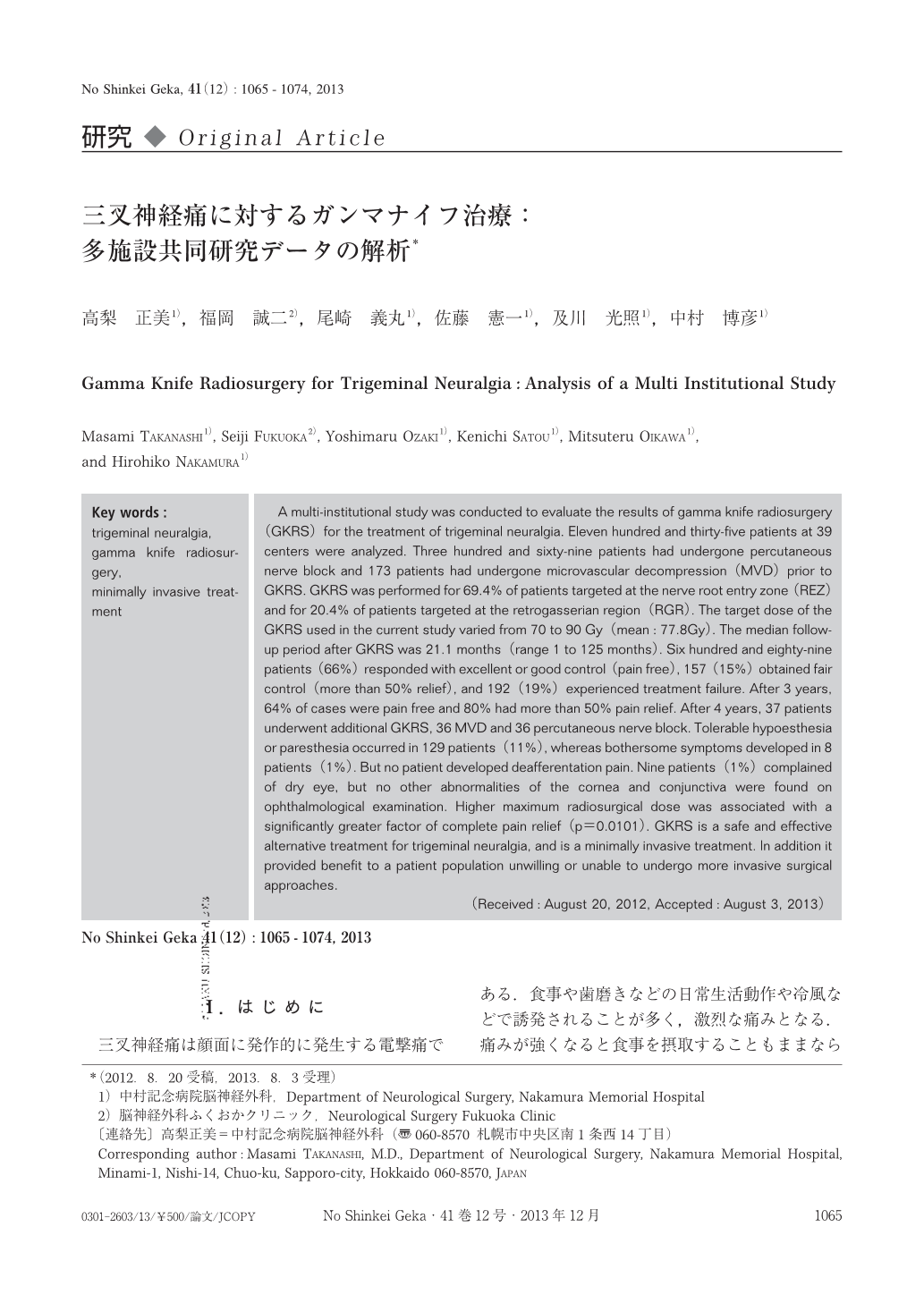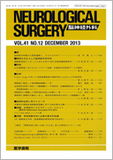Japanese
English
- 有料閲覧
- Abstract 文献概要
- 1ページ目 Look Inside
- 参考文献 Reference
Ⅰ.はじめに
三叉神経痛は顔面に発作的に発生する電撃痛である.食事や歯磨きなどの日常生活動作や冷風などで誘発されることが多く,激烈な痛みとなる.痛みが強くなると食事を摂取することもままならなくなり,家庭内生活や仕事に支障を来し,quality of life(QOL)を著しく低下させる.三叉神経痛に対する治療は,一般的にカルバマゼピンなどの薬物治療から開始される.しかし,薬物による治療効果が不足したり,薬物服用開始時に得られた効果が徐々に低減することがある.また,薬物に対するアレルギー反応やめまい,ふらつきなどの副作用から服用が継続できないこともある.
薬物治療以外の治療として,外科的治療には経皮的な治療と開頭手術がある.経皮的治療では末梢神経に対する神経ブロック治療や神経節に対するグリセロールや熱を使用したrhizotomy(神経根切断術)が行われる.これらの治療では施行後の効果発現は速やかであるが,治療部位のしびれや感覚低下を伴ったり,長期的な治療効果が安定しない場合がある.開頭手術である神経血管減圧術(microvascular decompression:MVD)は,三叉神経を圧迫して疼痛を発現させている血管を神経から剝離する.高い効果が得られることが多いが,全身麻酔の使用が必要であり,侵襲性,また手術合併症の面から適応とならない症例がある.
三叉神経痛に対するガンマナイフ治療はLeksellによって1971年に最初に報告されている13).この報告の時点では,ターゲット(照射位置)を三叉神経節においてガンマ線照射による治療が行われた.治療症例が重ねられたがその効果は不安定であった.その後,三叉神経の脳槽内走行部(脳幹起始部からMeckel腔入口部まで)にターゲットをおいた治療の効果が高いことが報告され,治療経験が蓄積されてきた.これによりガンマナイフ治療の有効性と安全性が高いことが認められ,数多くの症例に対して治療が行われている.ガンマナイフ治療は薬物治療が難しい症例,MVDが施行できない症例,高齢者などにも適用できる7).さらに近年では社会構造が高齢化を来していること,またできるだけ低侵襲な治療(minimally invasive treatment)を求める観点からガンマナイフ治療を選択する症例が増加していると考えられる.
この報告では,多施設共同研究として三叉神経痛に対してガンマナイフ治療を施行している施設の治療実態をアンケート調査により集積した結果(2004年)に基づき,治療効果や副作用などを分析,定量的に評価して治療の妥当性と安全性を検討した.
A multi-institutional study was conducted to evaluate the results of gamma knife radiosurgery(GKRS)for the treatment of trigeminal neuralgia. Eleven hundred and thirty-five patients at 39 centers were analyzed. Three hundred and sixty-nine patients had undergone percutaneous nerve block and 173 patients had undergone microvascular decompression(MVD)prior to GKRS. GKRS was performed for 69.4% of patients targeted at the nerve root entry zone(REZ)and for 20.4% of patients targeted at the retrogasserian region(RGR). The target dose of the GKRS used in the current study varied from 70 to 90 Gy(mean:77.8Gy). The median follow-up period after GKRS was 21.1 months(range 1 to 125 months). Six hundred and eighty-nine patients(66%)responded with excellent or good control(pain free), 157(15%)obtained fair control(more than 50% relief), and 192(19%)experienced treatment failure. After 3 years, 64% of cases were pain free and 80% had more than 50% pain relief. After 4 years, 37 patients underwent additional GKRS, 36 MVD and 36 percutaneous nerve block. Tolerable hypoesthesia or paresthesia occurred in 129 patients(11%), whereas bothersome symptoms developed in 8 patients(1%). But no patient developed deafferentation pain. Nine patients(1%)complained of dry eye, but no other abnormalities of the cornea and conjunctiva were found on ophthalmological examination. Higher maximum radiosurgical dose was associated with a significantly greater factor of complete pain relief(p=0.0101). GKRS is a safe and effective alternative treatment for trigeminal neuralgia, and is a minimally invasive treatment. In addition it provided benefit to a patient population unwilling or unable to undergo more invasive surgical approaches.

Copyright © 2013, Igaku-Shoin Ltd. All rights reserved.


